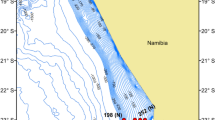Abstract.
The three meiobenthic ostracod species Candona neglecta, Paracyprideis fennica and Heterocyprideis sorbyana are commonly encountered in the deep (20–40 m) soft bottoms of the Baltic proper, and may contribute more to the total meiobenthic biomass than any other group. Experimental data indicate substantial differences in their utilisation of settling phytodetritus, with C. neglecta able to exploit newly settled organic material to a larger extent than P. fennica and H. sorbyana. Ostracod species composition, as well as ostracod and sediment carbon isotope contents, were studied in the field from an area with local differences in potential food resources. The study was performed during the late period of summer blooms of the cyanobacteria Aphanizomenon sp. Results showed that when all samples were taken together, adult C. neglecta (–22.4‰) was significantly more depleted in δ13C than adult P. fennica (–21.0‰) and H. sorbyana (–20.3‰), indicating differences in food selection among the species. The flocculent sediment layer had, in all instances, lighter carbon ratios than did the lower layers. This trend was mirrored in most cases in the slight enrichment in C. neglecta compared to generally greater enrichment in the other two species. Carbon signatures of C. neglecta also varied significantly between stations, indicating that this species fed on different resources depending on location. Juvenile C. neglecta were far more depleted in δ13C than adults and reflected the carbon signature of the cyanobacteria Aphanizomenon sp. The latter is known to be the most δ13C-depleted phytoplankton member in the area.
Similar content being viewed by others
Author information
Authors and Affiliations
Additional information
Electronic Publication
Rights and permissions
About this article
Cite this article
Limén, .H., Ólafsson, .E. Ostracod species-specific utilisation of sediment detritus and newly settled cyanobacteria, Aphanizomenon sp., in the Baltic Sea: evidence from stable carbon isotopes. Marine Biology 140, 733–738 (2002). https://doi.org/10.1007/s00227-001-0739-8
Received:
Accepted:
Issue Date:
DOI: https://doi.org/10.1007/s00227-001-0739-8




